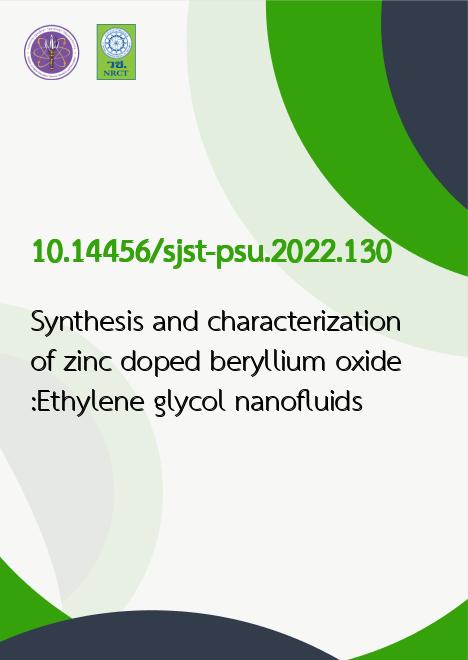
|
Synthesis and characterization of zinc doped beryllium oxide:Ethylene glycol nanofluids |
|---|---|
| รหัสดีโอไอ | |
| Creator | 1. P. Prakash 2. J. Catherine Grace John 3. T. Merita Anto Britto 4. S. Rubila 5. A. Kingson Solomon Jeevaraj |
| Title | Synthesis and characterization of zinc doped beryllium oxide:Ethylene glycol nanofluids |
| Publisher | Research and Development Office, Prince of Songkla University |
| Publication Year | 2565 |
| Journal Title | Songklanakarin Journal of Science an Technology (SJST) |
| Journal Vol. | 44 |
| Journal No. | 4 |
| Page no. | 979-986 |
| Keyword | BeO nanoparticle, Sonication, beryllium sulphate, crystallinity index |
| URL Website | https://rdo.psu.ac.th/sjst/index.php |
| ISSN | 0125-3395 |
| Abstract | The current study used ultrasound-assisted chemical precipitation to create zinc doped beryllium oxide (BeO)nanoparticles. X-ray diffraction (XRD) and scanning electron microscopy (SEM) were used to characterize the synthesizedsamples. The effect of sonication on the size of zinc-doped BeO nanoparticles is discussed. The presence of zinc-doped BeOnanoparticles with an average crystallite size of 17.89 nm was established by X-ray diffraction. The FTIR peaks at 434.97 cm-1and 1,110.08 cm-1confirm Zn and Be in them. Sonication was used to disperse the nanoparticles in ethylene glycol, resulting in ananofluid. The nanofluids were prepared in six concentrations from 0.0005 to 0.0030 wt% and characterized by ultrasoundvelocity and Fourier transform infrared (FTIR) spectroscopy as well as photoluminescence. Ultrasonic studies and FTIR analysisconfirmed the absence of particle-fluid interactions. The maximum intensity was at 510 nm wavelength in the photoluminescencespectra, giving the electron transition energy. Thermal conductivity and viscosity revealed an optimum concentration at 0.0025wt% zinc-doped BeO in ethylene glycol nanofluid, for maximal heat transfer with the highest thermal conductivity of 0.265W/mK. |
